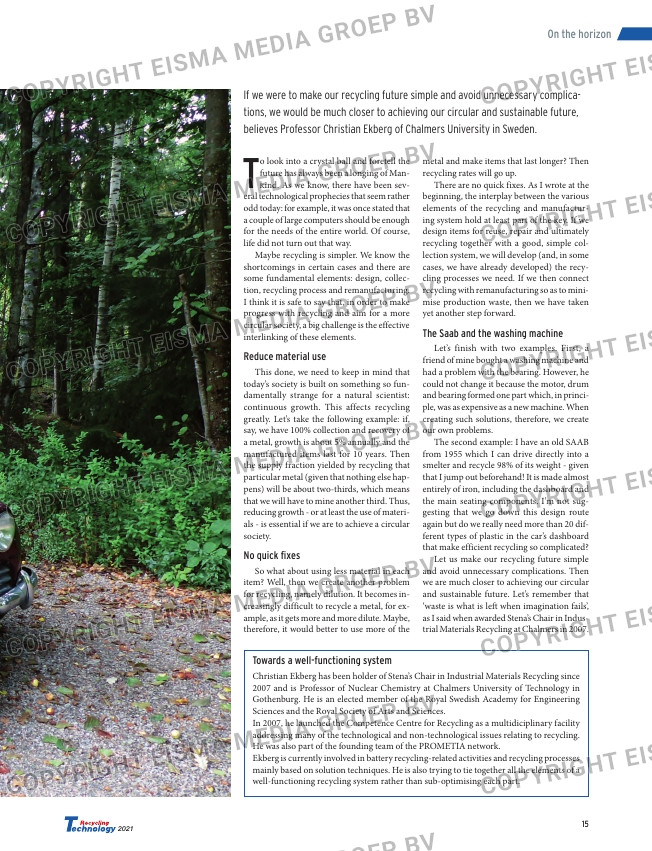Page 15 from: Out now: Recycling Technology 2021!

15
2021
On the horizon
If we were to make our recycling future simple and avoid unnecessary complica-
tions, we would be much closer to achieving our circular and sustainable future,
believes Professor Christian Ekberg of Chalmers University in Sweden.
T
o look into a crystal ball and foretell the
future has always been a longing of Man-
kind. As we know, there have been sev-
eral technological prophecies that seem rather
odd today: for example, it was once stated that
a couple of large computers should be enough
for the needs of the entire world. Of course,
life did not turn out that way.
Maybe recycling is simpler. We know the
shortcomings in certain cases and there are
some fundamental elements: design, collec-
tion, recycling process and remanufacturing.
I think it is safe to say that, in order to make
progress with recycling and aim for a more
circular society, a big challenge is the effective
interlinking of these elements.
Reduce material use
This done, we need to keep in mind that
today’s society is built on something so fun-
damentally strange for a natural scientist:
continuous growth. This affects recycling
greatly. Let’s take the following example: if,
say, we have 100% collection and recovery of
a metal, growth is about 5% annually and the
manufactured items last for 10 years. Then
the supply fraction yielded by recycling that
particular metal (given that nothing else hap-
pens) will be about two-thirds, which means
that we will have to mine another third. Thus,
reducing growth – or at least the use of materi-
als – is essential if we are to achieve a circular
society.
No quick fixes
So what about using less material in each
item? Well, then we create another problem
for recycling, namely dilution. It becomes in-
creasingly difficult to recycle a metal, for ex-
ample, as it gets more and more dilute. Maybe,
therefore, it would better to use more of the
metal and make items that last longer? Then
recycling rates will go up.
There are no quick fixes. As I wrote at the
beginning, the interplay between the various
elements of the recycling and manufactur-
ing system hold at least part of the key. If we
design items for reuse, repair and ultimately
recycling together with a good, simple col-
lection system, we will develop (and, in some
cases, we have already developed) the recy-
cling processes we need. If we then connect
recycling with remanufacturing so as to mini-
mise production waste, then we have taken
yet another step forward.
The Saab and the washing machine
Let’s finish with two examples. First, a
friend of mine bought a washing machine and
had a problem with the bearing. However, he
could not change it because the motor, drum
and bearing formed one part which, in princi-
ple, was as expensive as a new machine. When
creating such solutions, therefore, we create
our own problems.
The second example: I have an old SAAB
from 1955 which I can drive directly into a
smelter and recycle 98% of its weight – given
that I jump out beforehand! It is made almost
entirely of iron, including the dashboard and
the main seating components. I’m not sug-
gesting that we go down this design route
again but do we really need more than 20 dif-
ferent types of plastic in the car’s dashboard
that make efficient recycling so complicated?
Let us make our recycling future simple
and avoid unnecessary complications. Then
we are much closer to achieving our circular
and sustainable future. Let’s remember that
‘waste is what is left when imagination fails’,
as I said when awarded Stena’s Chair in Indus-
trial Materials Recycling at Chalmers in 2007.
Towards a well-functioning system
Christian Ekberg has been holder of Stena’s Chair in Industrial Materials Recycling since
2007 and is Professor of Nuclear Chemistry at Chalmers University of Technology in
Gothenburg. He is an elected member of the Royal Swedish Academy for Engineering
Sciences and the Royal Society of Arts and Sciences.
In 2007, he launched the Competence Centre for Recycling as a multidiciplinary facility
addressing many of the technological and non-technological issues relating to recycling.
He was also part of the founding team of the PROMETIA network.
Ekberg is currently involved in battery recycling-related activities and recycling processes
mainly based on solution techniques. He is also trying to tie together all the elements of a
well-functioning recycling system rather than sub-optimising each part.
14-15_horizon-ekberg.indd 15 09-09-20 09:03



